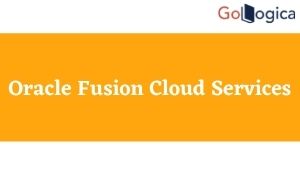
Introduction:

By going to this article, the readers will know the detailed insights about Oracle Fusion Cloud and the challenges for Oracle in implementing the same in the near future. Also, you will understand the future strategy of Oracle for cloud services briefly.
Over the past few years, there have been many talks regarding the Oracle Fusion, and also, many people struggle in understanding what exactly it means. Oracle Fusion refers to the Oracle Cloud infrastructure and new application development, specially designed for subscription and cloud services. In recent times, Oracle has focused communications on the process of business value and the use of these applications and also the underlying technology as “Cloud.”
Challenges for Oracle:
As per the recent survey of Forrester, Oracle has underperformed with the Fusion applications. As the users/customers are refusing to switch to the expensive Oracle Fusion applications and Oracle customers are often making it very difficult for the company to grow the application’s revenue.
Sixty-five percent have no plans to move to the Oracle Fusion Application, and the remaining 24% are on the fence. The fusion immaturity and Oracle’s muddled application strategy are the biggest barriers that became available in November 2011. Oracle has also experienced very low levels of user adoption, especially of the next-generation enterprise application suite and Fusion applications.
The recent acquisitions of the software-as-a-service companies like RightNow technologies and Taleo are not getting enough revenue, and users/customers showed little interest while trying the SaaS products, with having % of the survey respondents interested while making a move. From some of its customers, Oracle is in danger of losing its business. Forrester has found 29% of the organizations it polled were planning to move to another vendor’s packaged application or SaaS product. Their unhappiness with the Oracle was high maintenance costs, licensing costs, and difficulty in upgrading.
Oracle has invested in Fusion applications and middleware, and it can be one of the largest areas of growth for the organization, and it will not allow its users/customers to ignore them. Also, Oracle will not allow the applications, unlimited users, to stay where they are anywhere/forever.
Oracle will also focus more on the customers in order to move to Oracle Fusion or Oracle cloud infrastructure products in the near future. Later or soon, customers will start feeling pressure from Oracle to stay with the earlier technology.
Oracle Fusion Applications are the main strategy for defending against many fast-growing competitors of SaaS and growing software revenue. Oracle Cloud’s offering of CRM (Customer Relationship Management), HCM (Human Capital Management), and ERP (Enterprise Resource Planning) applications are the strongest in the industry.
Deploying Oracle Application on the Cloud:
Oracle Cloud infrastructure is appealing to every IT company as these are reliable, scalable, cost-effective, and secure. Also, Oracle is not recommending the users to shift the production environments to the cloud straight away, in order to make this process easier, Oracle has also published machine images of JD Edwards EnterpriseOne 9.2, E-Business Suite 12.2.2, and PeopleSoft HCM 9.2 on the marketplace of Oracle Cloud to create instances of the Oracle cloud applications.
Instead of downloading, installing, staging software, and configuring, the customers/users will also save time by deploying the image from the marketplace. After deploying the software in the cloud, the user/customer can use the environments to test new functionality, create setups, conduct CRPs or POCs and implement the flow of the business. For the existing applications, unlimited customers can test environments and migrate Dev to the Oracle Cloud.
Oracle continuously innovates the present applications under Oracle applications unlimited and delivers the next generation Oracle Cloud applications.
Oracle Cloud is the integrated public cloud that offers best-in-class services across the platform as a service (PaaS), software as a service (SaaS), and infrastructure as a service (IaaS). Oracle cloud ensures the companies drive business transformation and innovation by reducing IT complexity, lowering costs, and increasing business agility.
Also Read: An Overview of Oracle Fusion Receivables
What are Oracle Fusion Applications?
Incorporating the best practices that are gathered from the customers of Oracle and using the latest technology, the Oracle Fusion Applications are a suite of the open standards-based applications of the business which offer a standard for adopting technology and business innovation. Delivered as an entire suite of service-enabled enterprise applications, modular Oracle Fusion applications work with the Oracle applications portfolio in order to evolve the business to the latest and new level of performance. Whether it is a product family, one module, or the entire suite, Oracle offers businesses the choice of the advancements pioneered by the Oracle Fusion Applications at a pace that can match the individual business demands.
Fusion applications can best be described as:
- Based on the best practices business process
- Built on a platform of open standards
- Built with security as a priority
- Deployed via a selection of options
Standards-Based Architecture:
Oracle Fusion Applications are highly adaptable and are standard-based. It enables the user to respond very effectively to change with modular, flexible, user-driven business software that is powered by the best-in-class business capabilities established on open standards.
It includes the following products:
- Oracle Business Intelligence 11g offers a range of capabilities in business intelligence that enable the user to present, analyze, deliver company data and report.
- Oracle WebCenter offers runtime and design time for building transactional websites, enterprise portals, and social networking sites.
- Oracle universal content management enables the user to leverage web content management, document management, records retention functionality, and digital asset management to complement and build your business applications.

- Oracle WebLogic Server is an enterprise-ready application server based on Java EE.
- Oracle Enterprise Manager provides an integrated application for disk management, business-driven applications management, support experience, and integrated systems management.
- Oracle Identity Management enables the companies to manage the lifecycle of user identities for secure access to the enterprise assets and resources.
Conclusion:
Oracle Fusion applications are broadly divided into four software categories:
- Human capital management
- Customer relationship management
- Supply chain management
- Enterprise resource planning
Present cloud applications suite consists of Financials, CRM, Risk, Governance, and Compliance, Project Portfolio Management, Procurement, and SCM within these groups, also some sub-categories offer organizations many layers of modules and services. In addition to the on-premises setups, these applications are delivered via the Oracle Cloud. The Oracle Cloud application suite had gained momentum rapidly, and also, there was functionality being added regularly, having major releases three times in a year.
Any doubts regarding Oracle Fusion Cloud Services? Contact: Gologica: 82969 60414.
